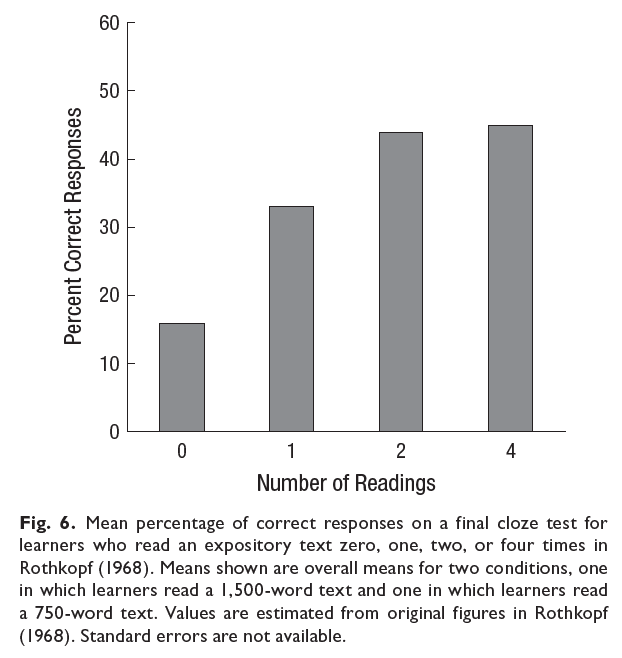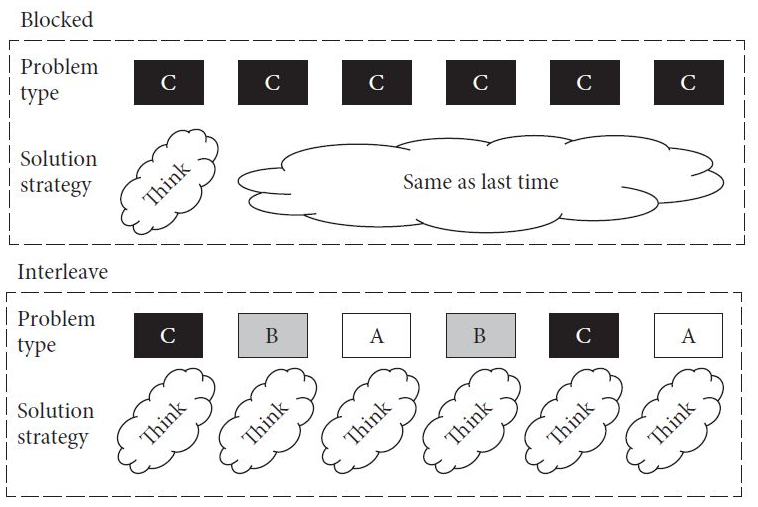Three Secret Sauces Behind the Magic of SuperMemo's Incremental Reading

Photo by Artem Maltsev on Unsplash
I believe it is the learning strategies of re-reading, distributed practice (spacing) and interleaved practice (mixing) that mediate the effectiveness and efficiency of Incremental Reading. I think they provide a window to explain the magic of Incremental Reading.
I also believe the benefits of these learning strategies demonstrated in the literature is transferable to Incremental Reading, i.e., if it works in the experimental settings it should also work in Incremental Reading, and this is what this article is about.
Secret Sauce I: Re-reading
Literature Review of Re-reading
Most of these studies reported an advantage of massed rereading over a single reading.
In an early study, undergraduates read an expository text zero, one, two, or four times. Rereading was massed i.e., each presentation of a text occurred immediately after the previous presentation. Performance improved as a function of number of readings.

Most of the benefits of rereading over a single reading appear to accrue from the second reading: The majority of studies that have involved two levels of rereading have shown diminishing returns from additional rereading trials.
A relatively consistent advantage for spaced rereading over a single reading has been shown both on immediate tests and on tests administered after a 2-day delay.
The following is one often-overlooked aspect of Incremental Reading:
II. Re-reading extracts (highlighted materials) in a spaced manner (distributed practice)
Therefore, for every extract, you’re reading it more than once.
1st caveat: Different intervals in re-reading
The above study: re-reading occurred immediately
Incremental Reading: days, weeks or even months apart
2nd caveat: Different meaning of re-reading
The above study: re-reading the whole material
Incremental Reading: Only re-reading the extracts you’ve created
My major takeaway is that, regardless of the spacing schedule (re-reading twice: either immediately or reading it again the next day), reading more than once is better than reading only once. In Incremental Reading, you are reading your extracts more than once for sure (at least twice): first time when you extracted it; second time when SuperMemo shows it to you. Even if you’ve decided it’s not worth further processing and dismissed it right away, you still would have read it twice.
Another takeaway is that the law of diminishing returns applies beyond reading it twice. This is why SuperMemo limits passive review of extracts:
Reviewing extracted important fragments at later time will have an excellent impact on your ability to remember. However, once the time between reviews increases beyond 200-300 days, reading and re-reading (passive review) will often result in insufficient recall. For this reason, sooner or later, you will need to convert your texts to specific questions. Incremental Reading
However, in head-to-head comparisons of learning techniques, rereading has not fared well against some of the more effective techniques discussed. For example, direct comparisons of rereading to elaborative interrogation, self-explanation, and practice testing have consistently shown rereading to be an inferior technique for promoting learning.
Therefore, among the three secret sauces, re-reading is the least secret sauce and with the least impact. Like a course meal, the main course is distributed practice and interleaved practice; re-reading is just the appetizer/dessert. Further breaking it down, re-reading isn’t the end goal in SuperMemo; it’s a mean, a mid-point, a by-product towards the end goal: clozed/Q&A items (Incremental Extract Processing). Regardless, re-reading is a component of Incremental Reading.
Secret Sauce II: Distributed practice
Literature Review of Distributed Practice
Distributed practice refers to a particular schedule of learning episodes.
The distributed-practice effect refers to better learning when learning episodes are spread out in time than in close succession.
One potential confusing point upfront:
Distributed practice only means the schedule itself, not what you do during that schedule:
Distributed practice + retrieval practice = SuperMemo/Anki (recall an answer 5 days later)
Distributed practice + reading = Incremental Reading (continue reading 5 days later)
Spaced rereading consistently outperforms massed rereading on delayed tests._
Rereading is generally most effective when completed after a moderate delay rather than immediately after an initial reading.
In a study, learners read a lengthy expository text and then reread it immediately afterward, 4 days later, or 3.5 weeks later. Two days after rereading, all participants completed a final test. Performance was greater for the group who reread after a 4-day lag than for the massed rereaders.
Spaced rereading appears to be effective at least across moderate lags, with studies reporting significant effects after lags of several minutes, 15-30 minutes, 2 days, and 1 week. [The lag effect]
One aspect of the learning conditions that does significantly moderate the effects of rereading concerns the lag between initial reading and rereading.
All these point to the fact that spaced re-reading is superior than massed re-reading. Incremental Reading is just spacing your reading for both point I and point II:
I. Reading the source material from start to finish in a spaced manner (distributed practice)
II. Re-reading extracts (highlighted materials) in a spaced manner (distributed practice)
I believe the benefits of the spacing effect is generalizable to Incremental Reading and it is far superior than any traditional Linear Reading (traditional = massed and linear = unidirectional).
Secret Sauce III: Interleaved Practice
Literature Review of Interleaved Practice
Interleaved practice means alternating your practice of different kinds of items or problems.
Explanation from the research paper:
For the solving sequences:
Group A (blocked):
Cube > Cube > Cube > Pyramid > Pyramid > Pyramid > Sphere > Sphere > Sphere
Group B (interleaved):
Cube > Sphere > Pyramid > Sphere > Pyramid > Sphere > Cube > Pyramid > Cube
Students’ percentages of correct responses during the practice sessions and during the criterion test are presented in Figure 13, which illustrates a typical interleaving effect: During practice, performance was better with blocked practice than interleaved practice, but this advantage dramatically reversed on the criterion test, such that interleaved practice boosted accuracy by 43%.

Distributed practice is about the time-frame, whereas interleaved practice is about the reading/reviewing arrangements, the presentation sequences.
Distributed practice: reading/reviewing schedules
Interleaved practice: reading/reviewing sequences
Explanation in Anki’s terms: If you recall from my previous post that Incremental Reading is just “reading cards”, Incremental Reading’s Interleaved practice is like creating a custom deck for all “reading cards”. This custom deck is one giant deck that includes all “reading cards” from every deck. All the reviewing schedules are sorted and presented accordingly.
Application of Interleaved Practice in Incremental Reading
The following is just another perspective of micro-interleaving and macro-interleaving applied in Incremental Reading I wrote in The Significance of Incremental Reading in SuperMemo: Part II
In Incremental Reading, there are different ways of interleaving:
Micro-interleaving (Same source materials):
1. Among source materials (same book; different chapters):
Book A: Chapter 1 --> Chapter 3 --> Chapter 5 --> Chapter 2
2. Among extracts (produced from the same materials):
Book A: Chapter 1's extract --> Chapter 3's extract --> Chapter 5's extract --> Chapter 2's extract
3. Among the same source materials and extracts:
Book A: Chapter 1 --> Chapter 3's extract --> Chapter 5's extract --> Chapter 2
Macro-interleaving (different sources):
1. Among source materials (different books; different chapters):
Book A: Chapter 1 --> Book C: Chapter 3 --> Book D: Chapter 5 --> Book F: Chapter 2
2. Among extracts (produced from different source materials):
Book A: Chapter 1's extracts --> Book F: Chapter 3's extracts --> Book C: Chapter 5's extracts --> Book D: Chapter 2's extracts
3. Among different source materials and extracts:
Book A: Chapter 1 --> Book C: Chapter 3's extract --> Chapter 5 --> Book E: Chapter 2's extract
In other words, micro-interleaving is mixing its chapters and its extracts; macro-interleaving is mixing among different books' chapters and extracts.
In SuperMemo, macro-interleaving among different source materials and extracts (point 3) is the default setting. All these different granularity of interleaved practice serve to illustrate its subtler application, that it can be micro as well as macro. Interleaving can happen among the same category and across categories:
Mixing apples, oranges, pears is interleaving among the same category (fruits).
Mixing apples, meatballs, popsicles is interleaving among different food categories.
If you have no idea what I mean, in simpler terms, interleaved practice just means everything is mixed. Incremental Reading is mixing all of your source reading materials and extracts. Imagine SuperMemo is a bowl and you just throw everything into it. It mixes and synergizes everything.
Benefits of Interleaved Practice In Incremental Reading
This retrieval-practice hypothesis and the discriminative-contrast hypothesis are not mutually exclusive, and other mechanisms may also contribute to the benefits of interleaved practice.
In one session, all relevant materials are usually spaced apart because different materials are mixed. This promotes the retrieval of prior knowledge from long-term memory. For example, among extracts, interleaving forces you to make sense of a fragment you’ve extracted weeks ago. You need a little forgetting in order to trigger the retrieval process. This forces you to think.
For blocked reading, the relevant information for understanding is possibly saturated in working memory but this understanding is not lasting because it’s from working memory, not retrieved from long-term memory. True learning occurs when you retrieve knowledge from long-term memory and combine it with new information in working memory. In Anki’s term, “reading cards” in one deck are all related and this makes the retrieval practice easier, a bit like cheating.
By contrast, for interleaved reading, all relevant prior knowledge must be retrieved from long-term memory. You no longer have a cheating working memory where you’ve preloaded it with relevant information from reading from the same chapter for 30 minutes. You have to reload different and relevant prior knowledge in order to make sense of it. This retrieval of prior knowledge from long-term memory for understanding, whether conscious or not, boosts memory for the retrieved information as well as comprehension.

Source: The Oxford Handbookof Metamemory
Imagine you need five pieces of relevant information in order to understand a concept. With blocked reading, all those five pieces are in working memory and so you easily understand the concept. This is like cheating. On the other hand, with interleaved reading, you are presented with only one relevant information. You have to retrieve all the other four pieces in long-term memory in order to understand the concept. This forces you to think and make sense of it. This is effortful practice, desirable difficulty.
Also, with a new reading sequence, you’re revisiting the reading materials in a new way and this promotes new insights. Sometimes a different presentation sequence is enough to help you make sense of it, to induce the “aha” moment.
Leap of faith
In any experiment and research, the result is bounded to be complicated by its experimental designs and flaws, among other confounding factors. Although I’m fully convinced of the power of distributed practice and interleaved practice in the literature, it is a leap of faith to generalize their benefits towards Incremental Reading. Their benefits may be robust in the literature (hence they are rated “high” in utility in the paper), the particular ways Incremental Reading “works” will greatly affect their efficiencies and effectiveness guaranteed in the literature.
For example, it is a leap of faith to go from “this study shows it’s better to study the material once, and then three days later” to “it’s equally good to space it across months or even years apart in SuperMemo”. Or combining distributed practice with re-reading (spaced re-reading) may produce a synergistic effect, or it may completely annihilate their respective effects. I don’t know. Since the learning science will never have definitive answers on these matters, I can only “take it and run with it”. Nonetheless, I’m convinced that Incremental Reading is the best reading (learning) tool we currently have.